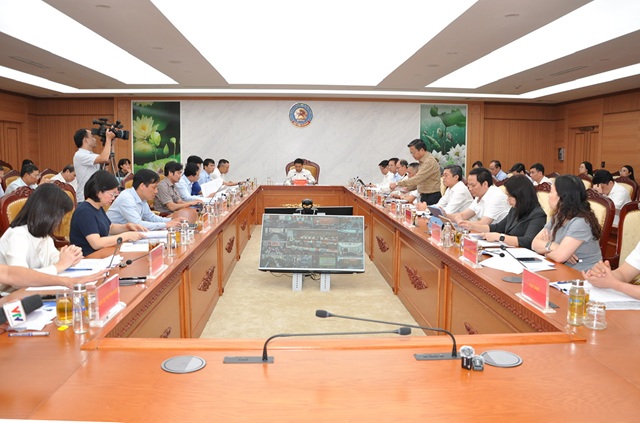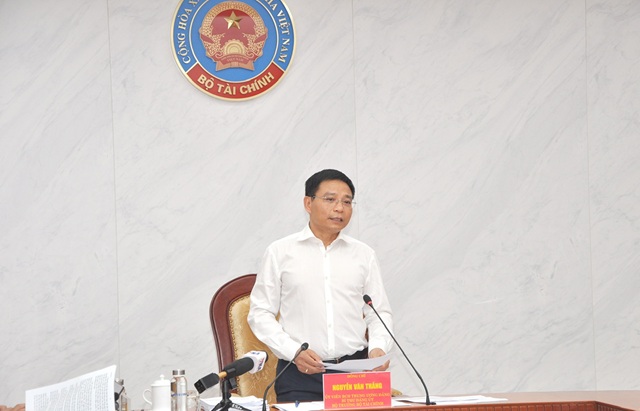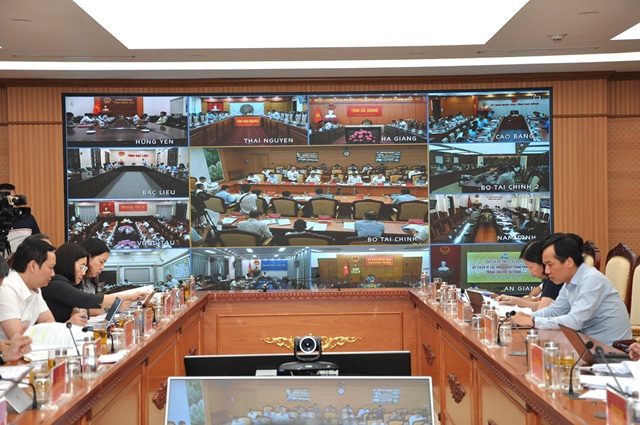
|
A national online conference was held to gather feedback on draft legal documents related to decentralization and delegation of authority in conjunction with the two-tier model of local government in the field of finance.
|
“Where there is effectiveness and efficiency, there will be delegation of authority.”
On May 26, the Ministry of Finance organized a national online conference to gather feedback on draft legal documents related to decentralization and delegation of authority in conjunction with the two-tier model of local government in the field of finance. The conference was chaired by Minister of Finance Nguyen Van Thang, with the participation of central ministries, departments, and all 63 provinces and cities.
In his opening remarks, Minister Nguyen Van Thang emphasized that in implementing Conclusion No. 155 of the Politburo on decentralization and delegation of authority, the Ministry of Finance has urgently reviewed the legal system and proceeded to amend and supplement relevant provisions. This includes a range of areas such as public investment, bidding, state budget management, financial statistics, public assets, and price management.
The Minister shared that this review process has received close coordination from relevant ministries and departments, especially the Ministry of Justice. Based on this, the Ministry of Finance has proposed amendments to important laws such as the Law on Management and Use of Public Assets and the Law on Personal Income Tax, while also preparing to submit new draft laws such as the Law on Thrift Practice and Anti-Wastefulness and the Law on Investment.
Not stopping at law amendments, the Ministry of Finance has also taken the initiative in developing and submitting to the National Assembly and the Government 10 resolutions on mechanisms and policies for 10 provinces and cities. Notably, 27 policies related to delegation of authority have been and are being implemented in local areas. At the 8th session of the 15th National Assembly, policies on delegation of authority were also institutionalized in the Law on Investment, the Law on Urban-Rural Planning, and the Law on Cultural Heritage.
Emphasizing the importance of listening and maximizing the absorption of feedback, Minister Nguyen Van Thang highlighted the spirit of “running while arranging the queue”. Despite the tight timeline, the Ministry has endeavored to complete the drafts, send them for feedback from ministries, departments, and localities, and is currently in the process of appraisal at the Ministry of Justice.
The Minister stated that the goal is to develop legal documents that are not only procedurally correct but also feasible in practice, minimizing the need for amendments after issuance. Especially during the implementation process, if any difficulties arise, the Ministry of Finance is ready to make timely adjustments.
“The consistent view is to delegate authority where there is effectiveness and efficiency. This is not only a management principle but also a clear message for innovative thinking in organizing local governments,”
said the head of the Ministry of Finance.

|
Minister of Finance Nguyen Van Thang speaking at the conference
|
Localities agreed and looked forward to the early issuance of new regulations
Agreeing with the direction of promoting delegation of authority, localities such as Hanoi, Ho Chi Minh City, and Haiphong have provided positive feedback and specific suggestions to the Ministry of Finance.
From the perspective of Hanoi, the representative of the Municipal Department of Finance shared that the city’s functional agencies have urgently reviewed the draft. Despite the short feedback time, the contents of the draft were evaluated to be quite comprehensive, clearly defining the authority of each level from central to communal level. Hanoi’s leaders particularly hoped that the guiding documents would be issued before July 1 to ensure sufficient time for the implementation of the urban government model.
Similarly, the representative of Ho Chi Minh City shared that they had carefully studied the contents and directly worked with the relevant departments to reach an agreement. However, due to the large volume of work, Ho Chi Minh City mobilized the specialized departments to provide feedback. In addition, some specific issues regarding public investment disbursement, public assets, statistics, and taxes were also raised for clarification and supplementation.
Meanwhile, the representative of Haiphong suggested that the model of organization and the principles of transferring tasks when abolishing the district level should be clearly defined. Specifically, tasks that the communal level cannot handle should be transferred to the provincial level. In addition, it is necessary to clarify the tasks of the communes and the province in multi-communal projects, especially in public investment and bidding.
Haiphong also proposed delegating authority in divesting state capital and transferring authority over small-scale public non-business units. The locality’s view was that the stronger the delegation of authority, the greater the motivation for development if managed properly.
Moreover, many other ministries, departments, and provinces also sent written feedback or spoke at the conference. Overall, the opinions welcomed the innovative spirit but hoped for clear and consistent regulations to avoid overlaps.
Responding to some concerns from the localities, the leadership of the Ministry of Finance shared that from July 1, the delegation of authority and adjustment of authority among localities according to the two-tier model of local government would be fully ensured, providing a solid foundation for uninterrupted state budget management. Meanwhile, the systems of the State Treasury, Taxation, and Customs have also been adjusted accordingly to the new administrative boundaries, suitable for the financial organization model in each locality.
In case any difficulties arise, the Ministry of Finance will continue to study and make appropriate adjustments. Therefore, from July 1, localities can confidently implement financial and budgetary tasks according to the unified regulations.
Furthermore, after the National Assembly passes the relevant contents, many legal provisions will be concretized through decrees, thereby not causing difficulties in budget formulation and implementation. Thus, contents related to thorough delegation of authority, budget adjustment, planning, and organizational structure will continue to be closely coordinated.
“In the process of implementing planning, if there is a situation where an investor is implementing a detailed project but there is no planning for the subdivision or overall planning, the Ministry of Finance has calculated and handled these situations in the amended regulations. Specifically, planning at different levels can be carried out simultaneously, meaning that even without subdivision planning, detailed planning can still be approved and incorporated into higher-level planning. Regarding redundant assets after the merger, priority will be given to arranging them for essential sectors such as healthcare, education, greenery, and public works. Currently, after completing the arrangement, localities have the right to proactively call for investment and implement projects according to the approved planning,”
the leader of the Ministry of Finance illustrated.
The Ministry of Finance and the units agreed that close coordination between the central and local levels is necessary for the decrees and circulars to truly come into life and maximize their effectiveness.

|
The conference was conducted in an online format
|
Concluding the conference, Minister Nguyen Van Thang requested that localities and units that have not yet sent their feedback urgently complete and submit it to the Ministry within the day. Based on the collected feedback, the Ministry of Finance will maximize the absorption to revise the draft decrees, ensuring alignment with the spirit of decentralization and delegation of authority according to the Law on Government Organization and the Law on Local Government Organization in 2025.
At the same time, the Ministry of Finance has assigned the functional units to prepare the dossier for submission to the Ministry of Justice for appraisal. After completion, the dossier will be submitted to the Government before May 30. During this process, the Ministry also requested close coordination from the Government Office and the Ministry of Justice for timely appraisal, consultation with Government members, and signing according to the set schedule. In addition, at the 10th session of the 15th National Assembly in October 2025, the Ministry of Finance is expected to submit major draft laws, including the Law on Tax Administration, the Law on Personal Income Tax, the Law on Investment, the Law on Thrift Practice and Anti-Wastefulness. This is the next step in the journey to complete the financial legal system to thoroughly implement the direction of delegation of authority, administrative reform, and modernization of the national finance sector.
Minister Nguyen Van Thang also recommended that localities proactively summarize practical experiences and timely propose amendments and supplements to remove bottlenecks in organizational structure and improve management effectiveness. This is also an important part of realizing Resolution 66 – the goal of turning Vietnam into a modern industrial country with upper-middle income by 2030.
| In implementing the Conclusion of the Politburo, the Secretariat, the direction of the Government and the Prime Minister on the development of decrees on decentralization, delegation of authority, and determination of authority associated with the implementation of the two-tier model of local government, the Ministry of Finance has focused on reviewing 24 areas under its management and identified 563 contents, tasks, and authority to propose decentralization, delegation of authority, and rearrangement of the two-tier local government structure, belonging to 233 legal documents. This includes: 32 laws; 2 ordinances; 14 resolutions of the National Assembly; 84 decrees; 6 decisions of the Prime Minister; and 95 circulars of the Minister. At this conference, the Ministry of Finance gathered feedback on 5 decrees and 7 circulars. Among them, there is 1 decree on determining the authority of local governments according to the two-tier model of local government. Along with that are 4 decrees on decentralization and delegation of authority in state management by sector and field… |
Unveiling the Intriguing Parallels Between Anh Tai Tien Dat and Techcombank Sinh Loi Tu Dong
In the fourth installment of the Decoding the Auto-Profit Wave podcast series, renowned rapper Dinh Tien Dat takes center stage as he unravels his transformative journey from the world of art to business. This insightful episode, airing on the CafeF ecosystem at 10 AM on May 26, 2025, marks a pivotal moment as Dat divulges the turning point that shifted his mindset towards managing his financial flow.
The Evolution of Blockchain: Unraveling the Core Technology Behind Cryptocurrencies
Cryptocurrency is an exciting new frontier, and the legal landscape surrounding it is evolving in Vietnam. But before diving into the world of crypto investing, it’s crucial to develop a deep understanding of blockchain technology, the very foundation upon which these digital currencies are built.
Proposed Minimum Wage for the Merged Province-City Region
The Ministry of Home Affairs has compiled a list of commune-level areas that will be subject to the new regional minimum wage framework, as outlined in Government Decree No. 74/2024. This follows the recent merger of provincial and communal administrative units, with the ministry delineating four distinct regions for this purpose.
“Proposed Application of Minimum Wage Rates in Six Centrally Governed Cities”
The proposed salary adjustments for Hanoi and Ho Chi Minh City’s communal-level subdivisions are intriguing. Hanoi’s districts are expected to implement minimum wage standards based on Regions I and II, while Ho Chi Minh City’s will apply a more varied range, from Region I to Region III, reflecting the unique socioeconomic landscapes of these vibrant cities.





















